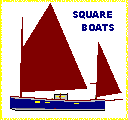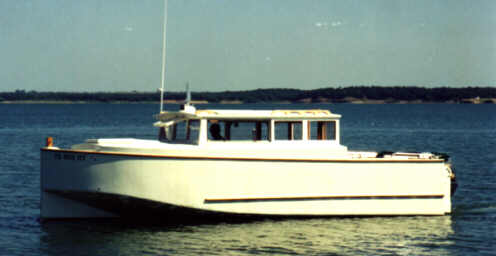|
Fast
Motorsailer 22'7"
x 8'0" x 9". Trailerable! |
|
|
|
|
Although it can be run purely as a power cruiser, the Fast Motorsailer design provides for outboard power, and includes 265 sq ft of dipping lugsail, with a single leeboard and offset rudder for sailing. Bolger provides an extended essay on the Fast Motorsailer in Boats with an Open Mind. J. Stephen Crim (of Richardson, Texas, USA) built and runs the Fast Motorsailer featured here. He's described building and using the boat in Messing About in Boats Vol 17, No 2 (1 June 1999), pp 18-20, from which much of the following is taken. Sadly, MAIB folded long ago but you might find a library copy somehwere... |
|
The wish list was for a truly trailerable (not just moveable) boat. We planned to trailer long distances to get to scenic cruising grounds, utilizing the boat as a "travel trailer" on the road when necessary. She had to be able to accommodate two people for at least a week or two on the water, and be relatively easy for a "mature couple" to launch, rig, and retrieve. I thought I wanted an option to sail, but knowing that most of our boating would be motoring, I also wanted to have some speed capability in reserve--to outrun weather, avoid larger vessels, or just get somewhere in a hurry. |
|
Concept...
The FMS utilises the Step Sharpie concept, in this case with the box cutwater meeting the hull bilges aft, rather than carried the full length of the boat. The FMS hull has a deadrise of about 20 degrees. There is a distinct flare at the bow where the bilge panels sweep upward. The FMS was designed to handle the rough waters of the US Pacific Northwest, and with her high topsides, she is quite dry. The box cutwater lifts the blunt bow clear of wave crests, the reserve buoyancy of that blunt bow prevents any chance of diving, the square-section main hull maximizes useable space, and the option to sail and conserve fuel is there too. |
|
Using... At the time I chose the FMS, I thought I wanted to be able to sail as well as motor...but I find that I really want to explore rivers, canals and lakes. The ability to sail her is not as important to me as I thought it would be. Besides, trailerability is of paramount importance, and I believe that the big mast, and the huge leeboard and rudder, would make trailering much more difficult.
At first I was concerned about hanging such a heavy motor on her, but with her beam, that 370 pound engine, plus 40 gallons of fuel, plus two batteries, as well as all our other gear, is no problem. I know she can even carry her own 2000-pound trailer quite easily, if one forgets to remove the tie-downs before launching...("Honey, why is the trailer floating? Did you put too much air in the tyres?") |
|
A bit on building... The FMS was my first endeavour as a boat builder, and I was tempted to first build a smaller boat for the experience (and perhaps to mitigate my exposure should my project fail). With Bolger's help, I was fortunate to find Bob Cushing, who has built a beautiful Fast Motorsailer as well as the Bolger Microtrawler and Chebacco. Bob's opinion was that the larger boat was no harder to build than the smaller one, so I decided to go for it.
Since the boat lives on a trailer, I didn't coat the MDO panels with epoxy before painting, though this might be advisable where a boat stays in the water. I did, however, fiberglass the 2' wide bottom of the cutwater for abrasion protection, and used a two-part epoxy paint below the waterline. During the building, I modified the interior to accommodate the extended cruising we want to do. The blunt forward section makes for a surprisingly wide V-berth. Our main cabin has a fairly typical (sedan) cruiser interior. The cabin profile was lengthened about 12" over the foredeck to create a shelf for electronics in front of the helm, and the cockpit sheerline increased about 4" to give more back support in the cockpit seating. Hatches were built into the cabin top allowing us to sit up on top occasionally. |
|
Fortunately, I was halfway through building when Bolger's Retriever and Champlain designs were introduced, or else I might still be trying to decide between the three designs. I think the newer designs are very handsome, but I would suggest that anyone interested in a cruising motorboat also consider the Fast Motorsailer, without her sailing rig, because she makes a fine motor cruiser. And there's still the sailing option. |
| Bolger Boats in
the Web | Square Boats home page |
Sick of Square Boats? Visit the Light Schooner!






